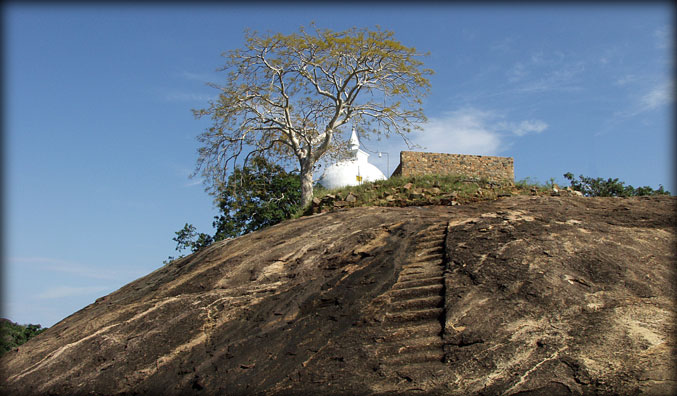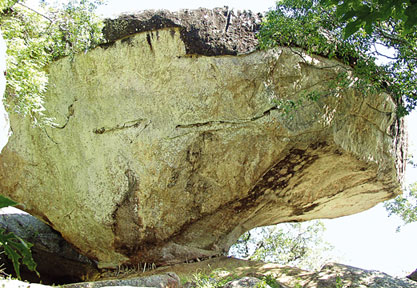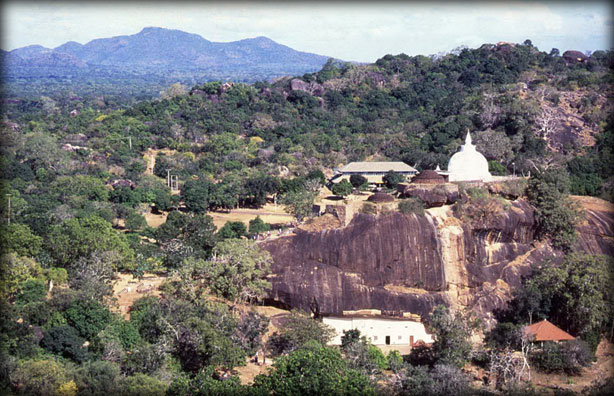|

A breathtaking view of the main Stupa atop the rocky outcrop
at Situlpahuwa. |
Situlpahuwa:
Hallowed abode of 12,000 monks
Story and pictures by Mahil Wijesinghe
Recently, I literally took a trip down memory lane when I made treks
to Situlpahuwa, a place my mother used to take me to when I was a kid.
This time, though my mind was awash with memories of mom and me, I went
as a photographer, eager to capture the serene beauty of this jungle
shrine in the Deep South.
I set off early to capture the morning rays streaming through the
widespread branches of the massive Palu and Weera trees along the gravel
path that leads to Situlpahuwa. I was travelling from Tissamaharama
across Yala Block-I, spotted a group of Malabar pie horn bills, through
forest canopy.
Situlpahuwa is located a few kilometres inside the magnificent Ruhuna
Wildlife Sanctuary (better known as Yala Wildlife Park) in close
proximity to the Magul Maha Viharaya. The site is famous for its 2nd
Century BC monastery. What appeals to visitors most is the panoramic
view of the 1,300-square-kilometre wildlife sanctuary, which runs right
down to the Indian Ocean.
The most noteworthy archaeological ruins are found in the large rock
outcrop of Situlpahuwa. Kings Kavan Tissa and Dutugamunu of 2nd Century
BC are attributed as being builders of these Stupas, rock cave shelters
and monastery.
|

The umbrella-shaped rock formation at Situlpahuwa |
Historic records indicate that Situlpahuwa in ancient time was named
ChittalapabbathaVihare, and had been the hallowed abode of 12,000 monks.
Testimony to this is the numerous rock water pools and the nearly ten
Stupas, all of which are now in ruins.
Maha Situlpahuwa
There are numerous Brahmi inscriptions in the Situlpahuwa area.
Around sixty such inscriptions have been brought to light by the
Archaeological Department through its excavation and restoration work.
Today, the monastery that was acclaimed as the greatest of its time
still stands strong, although numerous renovations have been made to the
original structure. More-recent additions are a pilgrim's rest, concrete
roads and a car park.
Between February and July, thousands of pilgrims come to worship at
the magnificent Stupa built on a rocky outcrop. Situlpahuwa gets its
name from the huge rock on which the Stupa had been built, though the
Stupa that's now in place is not as ancient as the rest of the
monastery. It had been built over the original Stupa and later
reconstructed. On the lower slopes, one can find the brick foundations
of two ancient Stupas, built as companion Stupas to the original.
On clear days, visitors climbing to the top of the rocky outcrop,
identified as Maha Situlpahuwa, can see the whole of the Ruhuna
sanctuary, right down to the sea on one side and the central hills on
the other. On the slope of this rocky outcrop lies the main shrine room
with the statue of a reclining Buddha. Archaeologists believe the site
of the shrine room was originally used by monks to meditate.
|

Conserved stone ruins |
|

The stone statues of Awalokitheswara
Bodhisatwa |
The two stone statues, one of which is headless, are believed to be
that of Bodhisatwa Awalokitheswara. The statues, both well preserved,
lie in front of the shrine room.
Scattered around the site are more than 60 inscriptions giving
credence to Situlpahuwa being a reputed Buddhist monastery in the past.
But more interesting to the adventurous visitor is a little path that
leads out from near the shrine room, through the banks of a greenish
water- filled pond, where crocodiles bask in the sun.
Less than a kilometre away through the jungle, the path leads to a
small Stupa, built atop another rocky outcrop. This is the Kuda
Situlpahuwa. For those whose interest extends beyond archaeology, this
is the exciting adventure, for the path takes the visitor into the
middle of the wilderness, where the jungle sounds prevails.
In this open space surrounded by thorny bushes, one can see many
species of rare birds like the Brahminy kite, the Serpent eagle,
Mountain hawk eagle and Malabar pie horn bill as well as the spotted
deer. Interestingly, a lone wild elephant also used to visit the
monastery daily, to get food from the temple.
Quaint offerings
 The most striking feature of Situlpahuwa lies a few yards up. This is
an umbrella-shaped rock leaning against another rock and forming a
passage of sorts. Beneath the first rock are broken branches and leaves,
quaint offerings from the pilgrims to the jungle deities seeking their
protection when venturing far into the jungle. The most striking feature of Situlpahuwa lies a few yards up. This is
an umbrella-shaped rock leaning against another rock and forming a
passage of sorts. Beneath the first rock are broken branches and leaves,
quaint offerings from the pilgrims to the jungle deities seeking their
protection when venturing far into the jungle.
Access to the second rocky outcrop is a near-vertical climb,
supported by a rickety iron handrail and tiny footholds carved into the
rock. The effort is worth it, just for the panoramic view that greets
you when you reach the top.
The second Stupa is called Kuda Situlpahuwa. Archaeologists claim
this was once linked to the main monastery by a paved path fringed with
flowering bushes. On both sides of the path are caves with rooms in
which the monks had meditated in the past. Of course the rooms are now
ruins.
The authorities of the temple advise visitors who venture to the Kuda
Situlpahuwa rock, to return to the main monastery before sunset. This is
an advice well worth heeding. |

